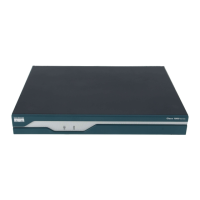16
Caution To prevent damage to the ejector mechanism, the ejector button next to the CompactFlash memory card must
remain fully seated when not being used to eject a CompactFlash memory card.
Power-Up Procedure
To power up your Cisco 1841 router and verify that it goes through its initialization and self-test, perform this procedure. When
the procedure is finished, the Cisco 1841 router is ready to configure.
Note To view the boot sequence, you must have a console connection to the Cisco 1841 router before it powers up.
Step 1 Make sure that your PC is powered up and connected as described in the “Checklist for Power Up” section on page 15.
Step 2 Move the power switch to the ON position. The SYS PWR LED on the front of the chassis blinks green and the fans
operate. If this does not happen, refer to the "Troubleshooting" module in the online Cisco 1800 series hardware
installation documentation at the following URL:
http://www.cisco.com/univercd/cc/td/doc/product/access/acs_mod/1800/hw/index.htm
Startup messages appear in your terminal emulation program window. When the startup messages end, the SYS PWR
LED comes on solid green.
Caution Do not press any keys on the keyboard until the messages stop and the SYS PWR LED is solid green. Any keys
pressed during this time are interpreted as the first command typed when the messages stop, which might cause the
router to power off and start over. It takes a few minutes for the messages to stop.
You may see different startup messages:
• If you see the following messages, the router has booted with a configuration file and is ready for initial
configuration using Cisco Router and Security Device Manager (SDM):
yourname con0 is now available
Press RETURN to get started.
Note Because SDM is installed on your router by default, we recommend using SDM to perform the initial
configuration.
If SDM is installed on your router, we recommend using SDM to perform the initial configuration. See the “Initial
Configuration Using Cisco Router and Security Device Manager” section on page 18 to learn how to configure your
router using SDM, or how to obtain SDM and install it on your router.
• If you see the following messages, the router has booted and is ready for initial configuration using the setup
command facility or the command-line interface (CLI):
--- System Configuration Dialog ---
At any point you may enter a question mark '?' for help.
Use ctrl-c to abort configuration dialog at any prompt.
Default settings are in square brackets '[]'.
Would you like to enter the initial configuration dialog? [yes/no]:
To learn how to use the setup command facility to configure the router, see the “Initial Configuration Using Setup
Command Facility” section on page 18. To learn how to use the CLI to configure the router, see the “Initial
Configuration Using Cisco CLI—Manual Configuration” section on page 21.

